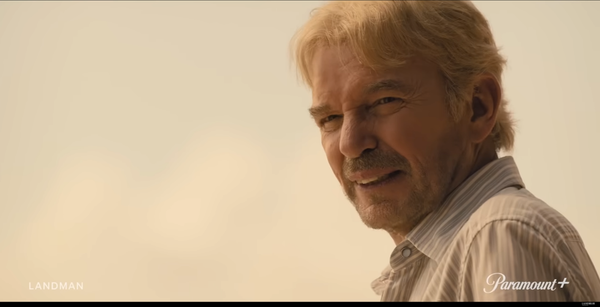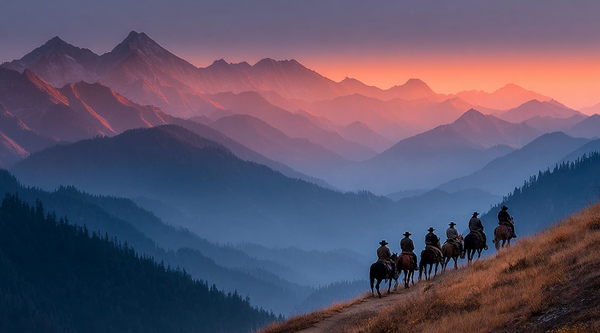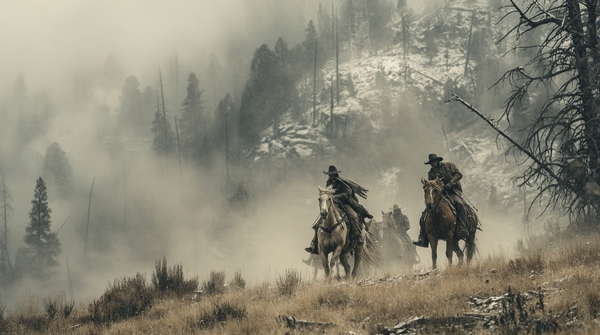The Violent Inheritance: On the Cruel Nostalgia of Taylor Sheridan's '1923'
A Landscape on a Dying Land
The opening tableau of 1923 is a Western vista inverted, a landscape of grim prophecy. Jacob Dutton (Harrison Ford) sits astride his horse, surveying a field littered with the carcasses of cattle, swollen and swarmed by flies, victims of disease and starvation.1 This is not the traditional portrait of the West as a domain of boundless opportunity and wealth, but a desolate pronouncement of ruin.1 It serves as both a mirror to the precarious state of the Dutton empire and a reflection of Montana itself in 1923, a land already in the grip of an ecological and economic catastrophe that foreshadows the coming Dust Bowl.1

Taylor Sheridan’s series situates the Dutton saga in a specific, often-overlooked moment in history. While much of America was swept up in the Jazz Age fervor of the “Roaring Twenties,” Montana was already deep in the throes of a severe depression. The agricultural boom that followed World War I had collapsed, with wartime commodity prices plummeting, followed by a devastating drought that had begun in 1917 and would last nearly a decade.2 This dual calamity precipitated a wave of bank failures, farm foreclosures, and a mass exodus of homesteaders. In the 1920s, Montana was the only state in the union to experience a net loss in population.3 The setting of
1923, therefore, is a peculiar "limbo era," caught between two world wars and before the Great Depression fully consumed the nation.1 From its inception, the Duttons’ struggle is not merely with a handful of rivals but with the formidable forces of history and ecology.
The series is a pivotal chapter in Sheridan’s expanding television universe, a cosmos built around grand themes of "generational inheritance, the maintenance of realm, and the defense of hard-won values, land and family".3 As a prequel to
Yellowstone and a sequel to 1883, 1923 bridges the gap between the family’s pioneer origins and their modern-day dynasty.3 The spectral narration of Elsa Dutton (Isabel May) from
1883 returns, linking the generations with a fatalistic refrain: "Violence has always haunted this family".3
Here, the foundational American myth of the frontier as a land of infinite possibility is thoroughly dismantled. In 1883, the West was a promised land of hope and rebirth. By 1923, the frontier feels less like a beginning and more like an end. The promise of the Homestead Act has curdled into unpayable debt and despair. The land itself, once a generous benefactor, has become a hostile antagonist. The story Sheridan tells is not one of forging a dream, but of fighting for survival as that dream threatens to become a nightmare. This is more than a simple Western narrative; it is a profound depiction of the American West’s first great economic and ecological failure. The Duttons are not building a future but battling a collapsing world, desperately holding on to a legacy paid for in their ancestors' blood.
An Empire of Dust: The Duttons and the Moral Quagmire of Property
At the heart of the Montana storyline lies Taylor Sheridan’s great obsession: property rights.3 The dispute between the Duttons and the Scottish shepherd Banner Creighton (Jerome Flynn) over grazing land is imbued with the "utmost moral stakes".3 When Jacob Dutton declares, in his stark cadence, that “stealing a man’s grass is like stealing another man’s steer,” a confrontation over a cut fence is elevated to a moment of supreme emotional gravity.3 This reflects a worldview where land ownership is not just an economic foundation but the very basis of existence.
The performances of Harrison Ford and Helen Mirren anchor the series. Ford, with his "sandpaper gravitas" 3, crafts a convincing patriarch. Jacob is the brother who arrived after the death of James (the protagonist of
1883) to save the family and build the ranch into an empire.5 He carries an authority weathered by hardship. Mirren, as the Irish matriarch Cara, delivers an even more commanding performance. Even when the dialogue veers into cliché, with homilies on the sacrifices of ranch life, Mirren invests the character with immense vitality and dignity.3 Their chemistry is authentic, that of a couple bound together by decades of shared struggle, and their presence lends a profound weight to the often-melodramatic proceedings.8
The setting during the Prohibition era adds another layer of chaos to an already tense society. Montana was an early adopter of Prohibition, but lax enforcement and corruption fostered a sprawling underground economy.10 Bootleggers, speakeasies, and the attendant violence further eroded an already fragile legal system.12 The conflict between the Duttons and their rivals is more than a private feud; it is symptomatic of a broader societal breakdown. In this world, official authority is a fiction, and disputes are ultimately settled by force.
The family’s signature trait—a willingness to employ extreme violence to defend their land—finds its historical justification here. It is less a character flaw than a direct product of their specific historical and economic crucible. In the Montana of the 1920s, every system is failing: the economy has collapsed 2, the banks are closing 3, the climate has turned hostile 3, and the law has been corrupted by Prohibition.10 To rely on any external institution for protection or prosperity would be suicidal. When Creighton’s flock is starving, cutting the Duttons’ fence is, in his view, not a crime but an act of survival.3 Jacob’s violent response is likewise framed as a primal, survivalist instinct. The "violence that haunts the family," then, is not some mystical curse but a learned, seemingly rational strategy for survival in a world without order. Through this historical framework, Sheridan provides a grim, almost deterministic origin story for the Dutton philosophy that echoes through all three series.
A Divided Frontier: A Tale of Three Worlds
Structurally, 1923 makes a bold, if sometimes jarring, choice: splitting its narrative into three almost entirely independent threads. This fragmentation, however, directly serves the show’s central theme of displacement. Each protagonist is, in a different way, torn from home and identity, and their stories collectively form a mosaic of loss and searching.
The Prodigal in Africa: Spencer's Long Road Home
The storyline of Spencer Dutton (Brandon Sklenar) unfolds like a self-contained, Hemingway-esque adventure saga.3 A veteran of the Great War, he has fled to Kenya to escape his PTSD by hunting big game. His encounter with the spirited English aristocrat Alexandra (Julia Schlaepfer) ignites a journey of romance and peril. Here, the antagonists are the elemental forces of nature: lions, leopards, storms, and shipwrecks.14 The production’s on-location filming in Kenya, Tanzania, South Africa, and Malta lends this arc an epic, cinematic quality.8 Yet this global scope also creates a sense of detachment from the desperate, earthbound struggle in Montana. Many critics have noted that this thread feels like "an entirely different series" 9, at times seeming like a "needless non-starter narrative detour" inserted to give Ford and Mirren a rest .
The School of Silence: Teonna's Ordeal
This is the series’ most harrowing and politically charged story. It follows Teonna Rainwater (Aminah Nieves), a young Crow woman, as she endures horrific abuse at a government-funded, Catholic-run boarding school for Native Americans.6 The show unflinchingly depicts the physical and psychological violence inflicted upon her, with the sadistic Sister Mary (Jennifer Ehle) and the menacing Father Renaud (Sebastian Roché) personifying a brutal system.3
This fictionalized account is rooted in a cruel and factual history. Beginning in the late 19th century, the U.S. government and various churches established hundreds of such schools with the explicit goal of forced assimilation, encapsulated by the infamous motto: "Kill the Indian in him, and save the man".16 Native children were forcibly taken from their families, their hair was cut, their names were changed, their languages were forbidden, their cultures were denigrated, and they were subjected to widespread physical, emotional, and sexual abuse.18 Teonna’s story is not overwrought melodrama but a dramatization of a state-sponsored cultural genocide. While Nieves’s performance has been praised as "anchoring and undaunted" 3, the storyline raises a serious question: "How much violence inflicted on Indigenous characters is too much to drive the point home?".3
The show’s controversial narrative fragmentation is not a flaw but a deliberate artistic choice. The structural disconnect mirrors a central theme: in a world where communities and individuals are violently torn from home and identity, existence itself is isolated and adrift. Jacob and Cara face economic displacement, the potential loss of their ranch. Spencer is geographically and psychologically exiled by his trauma, unable to return home. And Teonna suffers the most profound uprooting of all, forcibly severed from her family and culture. Every major character in the series is, in some sense, lost. Spencer’s entire plot is an arduous journey home; Teonna’s is a desperate flight to survive and return to her people; Jacob’s is a fight to hold onto the very idea of home. The viewer’s own sense of disorientation while jumping between these stories mirrors the fractured, dislocated experience of the characters themselves. The show’s form becomes an extension of its content. It does not just tell a story about a broken world; it feels like one.
The Sheridan Brand: Auteur of the New West
Taylor Sheridan is the undisputed auteur of the Yellowstone universe. His creative signature is unmistakable, his thematic preoccupations near-obsessive. He is known for his "allergy to exposition," favoring "absurdly simple plots" that allow him to focus entirely on character.20 His dialogue is often described as a form of "masculine poetry" 13, and he excels at creating morally ambiguous characters who "live in the gray".21 He insists on shooting in expansive, real landscapes, making the environment itself a character in the story.8
The central tension in Sheridan’s work is the juxtaposition of his romanticized vision of the American West with its brutal realities.11 He celebrates the "hard-as-nails men who tamed it" and the "salt-of-the-earth women who made it tolerable with their wisdom, wit and love," presenting a "patriotic, rose-tinted view of America".11 Yet alongside this romanticism is an unflinching depiction of the violence and suffering that accompanied that conquest, with Teonna’s storyline as the most potent example.
This duality has fueled intense debate about the ideology of his work. Sheridan’s shows are often labeled simply as "red-state" television 3, but a sharper critique argues that his entire universe functions as "wildly entertaining propaganda for a twenty-first-century style of manifest destiny".22 This view holds that by focusing on how the Duttons "defend" their land, Sheridan crafts a narrative that positions white settlers as victims, thereby rationalizing their ancestors’ violence as a universal human struggle for survival.22 An alternative reading, however, suggests that by including stories like Teonna’s, Sheridan is actively deconstructing the very myths he appears to celebrate, forcing his audience to confront the brutal aspects of the nation’s history.23
The phenomenal success of the Yellowstone universe lies in its masterful tapping of a deep, collective anxiety within settler-colonial societies. The Duttons’ perpetual fear of losing their land is an allegorical representation of a deeper, unspoken anxiety in American culture: a doubt about the legitimacy of its historical claims and a fear of being displaced by new demographic, economic, and cultural forces. In every Sheridan show, the central conflict is the defense of a "fiefdom" 11 against outsiders—be they Native Americans, coastal elites, or corporations.3 The threat is never resolved; it is an existential, rolling crisis. The Duttons can never truly be at peace, because their ownership is perpetually under question. This resonates with a subconscious anxiety in a nation founded on the displacement of Indigenous peoples, a historical original sin that leaves its founding myths inherently unstable. The audience is watching not just a family drama, but a dramatization of its own cultural anxieties. The show’s appeal is that it validates that feeling of being under siege and elevates it into a romantic epic of violent will, creating a powerful cultural feedback loop.
Conclusion: An Unsettled Legacy
1923 is an ambitious, sprawling epic, realized through magnificent global cinematography 8 and anchored by performances of immense gravity.9 Its narrative structure, however, can feel clumsy, with its component parts not always fitting together seamlessly.9 It is here that Brian Tyler’s musical score serves a crucial emotional through-line, with his theme for the Dutton saga acting as a unifying thread for the disparate stories.25
In an age of fragmentation and uncertainty, Sheridan’s grand, mythic storytelling—even when it is a story of failure, violence, and sorrow—speaks to a profound hunger for foundational narratives. 1923 offers no easy answers or flawless heroes. It presents the American West as a place of profound contradiction: a dream of freedom built on a reality of conquest, a landscape of breathtaking beauty stained by unimaginable cruelty. The series ultimately suggests that this turbulent, violent inheritance is a fate we all share.
Cited Works
- 1923 review: Harrison Ford and Helen Mirren lead intriguing Yellowstone prequel
- Montana Mosaic: The New Deal in Montana - PBS LearningMedia
- Homestead Act Launches a New Era in Montana (Part 3 of 3)
- The Great Depression - Montana Historical Society
- The Dutton Family Tree: Yellowstone, 1883, 1923 Characters - The Pioneer Woman
- 1923 (TV series) - Wikipedia
- 1923 Review – Harrison Ford & Helen Mirren Shine in Yellowstone Prequel
- 1923 Review: Harrison Ford and the show are full of potential | The Spool
- Harrison Ford calls 1923 costar Helen Mirren 'a real cool lady': 'No disparagement in calling a Dame a broad' - Entertainment Weekly
- Drunk and Disorderly: The Era of Prohibition - Bozeman Magazine
- Montana's Whiskey Women: Female Bootleggers during Prohibition
- Running of Moonshine from Canada to Montana During Prohibition: The Bootlegger Trail
- Transitioning into Prohibition — The History Museum
- '1923' Review: The Romanticized American West Continues To Be A Cruel & Hostile Place In Season 2 - The Playlist
- '1923' Review: Harrison Ford & Helen Mirren Light Up Taylor ...
- Remembering the Children of Native American Residential Schools
- American Indian boarding schools | EBSCO Research Starters
- History & Culture - Carlisle Federal Indian Boarding School National Monument (U.S. National Park Service)
- Chapter 3: Boarding Schools - Native Words, Native Warriors ...
- Taylor Sheridan - Wikipedia
- Screenwriting Wisdom from the Oscar-Nominated Taylor Sheridan ...
- Where Was '1923' Filmed? The Real-Life Locations Behind Taylor ...
- Harrison Ford Is Right About '1923's Greatest Strength - Collider
- I'm so in love with Harrison Ford and Helen Mirren in this show. They could not have cast anyone better.
- The Secrets Behind the Music of 'Yellowstone' and '1923' | Artisans - YouTube
- '1883' composer Brian Tyler explains how he wrote that 8-minute theme | GOLD DERBY



